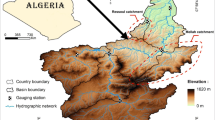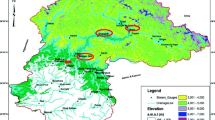Abstract
Artificial neural networks (ANNs) are promising alternatives for the estimation of suspended sediment concentration (SSC), but they are dependent on the availability data. This study investigates the use of an ANN model for forecasting SSC using turbidity and water level. It is used an original method, idealized to investigate the minimum complexity of the ANN that does not present, in relation to more complex networks, loss of efficiency when applied to other samples, and to perform its training avoiding the overfitting even when data availability is insufficient to use the cross-validation technique. The use of a validation procedure by resampling, the control of overfitting through a previously researched condition of training completion, as well as training repetitions to provide robustness are important aspects of the method. Turbidity and water level data, related to 59 SSC values, collected between June 2013 and October 2015, were used. The development of the proposed ANN was preceded by the training of an ANN, without the use of the new resources, which clearly showed the overfitting occurrence when resources were not used to avoid it, with Nash-Sutcliffe efficiency (NS) equals to 0.995 in the training and NS = 0.788 in the verification. The proposed method generated efficient models (NS = 0.953 for verification), with well distributed errors and with great capacity of generalization for future applications. The final obtained model enabled the SSC calculation, from water level and turbidity data, even when few samples were available for the training and verification procedures.



Similar content being viewed by others
References
Abudu S, Cui C-l, King JP, Abudukadeer K (2010) Comparison of performance of statistical models in forecasting monthly streamflow of Kizil River, China. Water Sci Eng 3(3):269–281
Alizadeh MJ, Shahheydari H, Kavianpour MR, Shamloo H, Barati R (2017) Prediction of longitudinal dispersion coefficient in natural rivers using a cluster-based Bayesian network. Environ Earth Sci 76(2):86
Afan HA, El-Shafie A, Yaseen ZM, Hameed MM, Mohtar WHMW, Hussain A (2015) ANN based sediment prediction model utilizing different input scenarios. Water Resour Manag 29:1231–1245
ASCE-Task Committee on Application of Artificial Neural Networks in Hydrology (2000) Artificial neural networks in hydrology. I: preliminary concepts. J Hydrol Eng 5(2):115–123
Barati R, Neyshabouri SS, Ahmadi G (2014) Development of empirical models with high accuracy for estimation of drag coefficient of flow around a smooth sphere: an evolutionary approach. Powder Technol 257:11–19
Bayram A, Kankal M, Önsoy H (2012) Estimation of suspended sediment concentration from turbidity measurements using artificial neural networks. Environ Monit Assess 184:4355–4365
Bayram A, Kankal M, Tayfur G, Önsoy H (2014) Prediction of suspended sediment concentration from water quality variables. Neural Comput & Applic 24:1079–1087
Brasil. Ministério da Agricultura. Departamento Nacional de Pesquisa Agropecuária. Divisão de Pesquisa Pedológica (1973) Levantamento de reconhecimento dos solos do estado do Rio Grande do Sul. Boletim Técnico. Recife: convênio MA/DPP – SA/ DRNR
Buyukyildiz M, Kumcu SY (2017) An estimation of the suspended sediment load using adaptive network based fuzzy inference system, support vector machine and artificial neural network Models. Water Resour Res 31(4):1343–1359
Castro NMR, Auzet A-V, Chevallie P, LEprun J-C (1999) Land use change efects on runof and erosion from plot to catchment scale on the basaltic plateau of southern Brazil. Hydrol Process 13(11):1621–1628
Edwards TK, Glysson GD (1999) Field methods for measurement of fluvial sediment. Techniques of water-resources investigations of the U.S. Geological Survey. In: Book 3 (applications of hydraulics). Chapter C2. USGS, Virgínia
FTS - Forest Technology System (2013) DTS-12 SDI turbidity sensor: user manual. 700-DTS-12-Rev
Garg V (2015) Inductive group method of data handling neural network approach to model basin sediment yield. J Hydrol Eng 20:C6014002
Gao P, Josefson M (2012) Temporal variations of suspended sediment transport in Oneida Creek watershed, central New York. J Hydrol 426-427:17–27
Haimann M, Liedermann M, Lalk P, Habersack H (2014) An integrated suspended sediment transport monitoring and analysis concept. Int J Sediment Res 29(2):135–148
Harrington ST, Harrington JR (2013) An assessment of the suspended sediment rating curve approach for load estimation on the rivers Bandon and Owenabue, Ireland. Geomorphology 185:27–38
He J, Valeo C, Chu A, Neumann N (2011) Prediction of event-based stormwater runoff quantity and quality by ANNs developed using PMI-based input selection. J Hydrol 400:10–23
Hecht-Nielsen R (1990) Neurocomputing. Addison - Wesely Publishing Company, Boston
Hornik K, Stinchcombe M, White H (1989) Multilayer feedforward networks are universal Approximators. Neural Netw 2:359–366
Hosseini K, Nodoushan EJ, Barati R, Shahheydari H (2016) Optimal design of labyrinth spillways using meta-heuristic algorithms. KSCE J Civ Eng 20(1):468–477
Lafdani EK, Nia AM, Ahmadi A (2013) Daily suspended sediment load prediction using artificial neural networks and support vector machines. J Hydrol 478:50–62
Lefrancois J, Grimaldi C, Gascuel-Odoux C, Gilliet N (2007) Suspended sediment and discharge relationships to identify bank degradation as a main sediment source on small agricultural catchments. Hydrol Process 21(21):2923–2933
Melo TM, Pedrollo OC (2015) Artificial neural networks for estimating soil water retention curve using fitted and measured data. Appl Environ Soil Sci 2015:16 Article ID 535216
Moosavi V, Talebi A, Hadian MR (2017) Development of a hybrid wavelet packet-group method of data handling (WPGMDH) model for runoff forecasting. Water Resour Manag 31(1):43–59
Mustafa MR, Rezaur RB, Saiedi S, Isa MH (2012) River suspended sediment prediction using various multilayer perceptron neural network training algorithms - a case study in Malaysia. Water Resour Manag 26:1879–1897
Nash JE, Sutcliffe JV (1970) River flow forecasting through conceptual models part I — a discussion of principles. J Hydrol 10:282–290
Nourani V, Kalantari O (2010) Integrated artificial neural network for spatiotemporal modeling of rainfall–runoff–sediment processes. Environ Eng Sci 27(5):411–422
Nourani V, Kalantari O, Baghanam AH (2012) Two Semidistributed ANN-based models for estimation of suspended sediment load. J Hydrol Eng 17:1368–1380
Nourani V, Parhizkar M, Vousoughi FD, Amini B (2014) Capability of artificial neural network for detecting hysteresis phenomenon involved in hydrological processes. J Hydrol Eng 19:896–906
Rajaee T, Nourani T, Zounemat-Kermani M, Kisi O (2011) River suspended sediment load prediction: application of ANN and Wavelet conjunction model. J Hydrol Eng 16(8):613–627
Rumelhart DE, Hinton GE, Williams RJ (1986) Learning representations by backpropagating errors. Nature 323:533–536
Sarkar A, Kumar R (2012) Artificial neural networks for event based rainfall-runoff modeling. J Water Resour Prot 4:891–897
Shellenbarger GG, Wright SA, Schoellhamer DH (2013) A sediment budget for the southern reach in San Francisco Bay, CA: implications for habitat restoration. Mar Geol 345:281–293
Singh VP, Frevert DK (2006) Watershed models. CRC Press, United States of America
Singh A, Imtiyaz M, Isaac RK, Denis DM (2012) Comparison of soil and water assessment tool (SWAT) and multilayer perceptron (MLP) artificial neural network for predicting sediment yield in the Nagwa agricultural watershed in Jharkhand, India. Agric Water Manag 104:113–120
Singh A, Imtiyaz M, Isaac RK, Denis DM (2013) Comparison of artificial neural network models for sediment yield prediction at single Gauging Station of watershed in eastern India. J Hydrol Eng 18:115–120
Su C-C, Lu J-Y, Hong J-H (2013) A field investigation of the sediment transport characteristics of a high sediment load intermittent river in Taiwan. Hydrol Process 27:4043–4056
Talebizadeh M, Seyyed SM, Ayyoubzadeh A, Ghasemzadeh M (2010) Uncertainty analysis in sediment load modeling using ANN and SWAT model. Water Resour Manag 24:1747–1761
Tananaev NI, Debolskiy MV (2014) Turbidity observations in sediment flux studies: examples from Russian rivers in cold environments. Geomorphology 218:63–71
Tóth B, Bódis E (2015) Estimation of suspended loads in the Danube River at Göd (1668 river km), Hungary. J Hydrol 523:139–146
Vogl TP, Mangis JK, Rigler AK, Zink WT, Alkon DL (1988) Accelerating the convergence of the back-propagation method. Biol Cybern 59:257–263
Walling DE (1977) Acessing the acuracy of suspended sediment rating curves for a small basin. Water Resour Res 13(3):531–538
West D, Dellana S (2011) An empirical analysis of neural network memory structures for basin water quality forecasting. Int J Forecast 27:777–803
Yazdani MR, Zolfaghari AA (2017) Monthly River forecasting using instance-based learning methods and climatic parameters. J Hydrol Eng 22(6):04017002
Acknowledgements
The authors would like to thank CNPq for the first author’s doctorate scholarship and for the second author’s research production grant, and FINEP for the allocation of resources for the basin monitoring in the projects “Research Network in Monitoring and Modeling of Hydrosedimentological Processes in Rural and Urban Representative Basins of the Atlantic Forest Biome” and “Assessment of the Sediment Input in Reservoirs Aiming at Increasing Water Availability”.
Author information
Authors and Affiliations
Corresponding author
Rights and permissions
About this article
Cite this article
Sari, V., dos Reis Castro, N.M. & Pedrollo, O.C. Estimate of Suspended Sediment Concentration from Monitored Data of Turbidity and Water Level Using Artificial Neural Networks. Water Resour Manage 31, 4909–4923 (2017). https://doi.org/10.1007/s11269-017-1785-4
Received:
Accepted:
Published:
Issue Date:
DOI: https://doi.org/10.1007/s11269-017-1785-4




